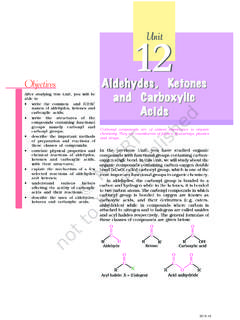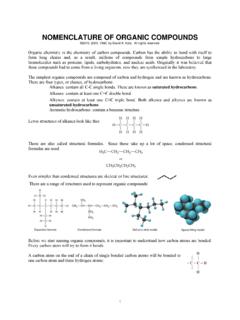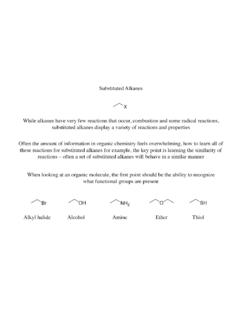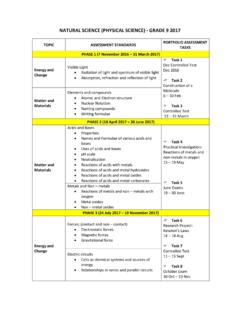Transcription of Table of Contents - keytomes.com
1 PrefaceviiTable of ContentsIntroduction (a) Shell number and number of subshells (b) Orbitals (c ) Orbital shapes (s, p & d) (d) Relative energies of s,p,d,f sub-shells 4A (e) Electron spin and spin pairing 4A (f) Aufbau principle (g) Ground state electron configurations (h) Electrons-in-a-box (i) Period 3 trends (j) Relationship between Group number and successive ionisation energies (a) Dot and cross diagrams (b) Molecular orbitals (c) Covalent bond strength (d) Sigma and pi bonds (e) Strengths of and bonds (f) Bond order (g) VSEPR theory (h) Changes in geometry and bond angles (i) Electronegativity and bond polarity (j) Van der Waals forces (k) Hydrogen bonding (l) Protein structure (a) Energy changes (b) Equation 1 (c) Hess s Law and the First Law of Thermodynamics 45 Sample PagesPre-U (d) Calculating Enthalpy Changes 1 (e) Calculating lattice enthalpies (f) Understanding catalysts (g) Enthalpy profile diagrams (h) Boltzmann distribution (a) What is entropy?
2 (b) Total entropy change ( Stotal) (c) Calculating S (d) Entropy change of the surroundings (e) Second Law of Thermodynamics (f) Gibbs free energy and the Gibbs energy equation (g) Gibbs Energy and the Equilibrium constant (K) (a) Le Chatelier s principle (b) Weak acids and weak alkalis (c) Equilibrium constant expressions (Kc) (d) Equilibrium constant expressions (Kp, Ksp, Ka & Kw) (e) Equilibrium constant calculations (f) pH and pKa (g) Acid base titrations and indicators (h) Buffer solutions (i) Quantitative electrolysis (j) Redox and oxidation number (k) Standard electrode potential and the standard hydrogen electrode (l) Measuring standard electrode potentials (practical) (m) Calculating standard cell potentials (theory) (n) Linking standard cell potential and Gibbs energy change (o) Electrochemical cells (p) Variation of cell potentials (equilibrium and non-standard conditions) 109 Sample (q) Hydrogen/oxygen fuel cell (a) Kinetic theory applied to an ideal gas (b) Boyle s law, Charles s law and the ideal gas equation (c) Boltzmann distribution (d) Rate constant and the Arrhenius equation (e) Homogeneous and heterogeneous catalysis (f) Rate equations and orders (g) Rate-determining step and mechanism (h) Mechanisms and rate equations (i) Deducing rate equations (j) First order reactions and half-life (a) Chemistry an evidence-based subject (b) Theories, models, facts & definitions (c) Breakdown of the ideal gas model (d) Limitations of the ionic model (a) Regions of the Periodic Table (b)
3 Structures of the Elements (c) Period 3 trends in terms of structure and bonding (d) Van Arkel diagrams (e) Oxidation number (f) Period 3 elements reactivity with oxygen (f) Period 3 elements reactivity with water (g) Period 3 oxides reactivity with water (h) Period 3 chlorides and water (i) Mineral oxides (a) Thermal decomposition of carbonates (b) Structures of nitrogen and white phosphorus (c) Unreactivity of nitrogen 166 Sample PagesPre-U (d) Acid-base behaviour of ammonia and the ammonium ion (e) Allotropes of oxygen (f) Redox properties of hydrogen peroxide (g) Removing sulfur oxides (fuels and power stations) (h) Properties and reactions of sulfuric acid (i) Trends in physical and chemical properties of the halogens (j) Halogens bond enthalpies (k) Trend in acidity of the hydrogen halides (l) Reaction of halides with concentrated H2SO4 (m) Reaction of iodine with sodium thiosulfate (n) Reactions of the halogens with cold NaOH (aq) (o) Fluorine.
4 Anomalous reactivity & high oxidation state fluorides (a) Allotropes of carbon (b) Transition from non-metal to metalloid to metal (c) Lead chemistry (mainly +2 oxidation state) (d) Transition from covalent oxides to ionic oxides (e) Bonding in divalent and tetravalent oxides (a) Comparing properties of transition elements and the s-block (b) Variation of properties across the series (c) Characteristic properties of transition elements (d) Octahedral, tetrahedral and square planar complexes (e) Geometric and Optical isomerism in complexes (f) d-orbital splitting in transition metal complexes (g) Origin of colour in transition metal complexes (h) Ligand exchange and observed colour changes (i) Redox chemistry Fe3+/Fe2+; MnO4-/Mn2+; Cr2O72-/Cr3+; Cu2+/Cu+ (j) Biological role of three important iron complexes (k) Stability of Co2+ and Co3+ with different ligands 228 Sample (a) Crystal structures of metals (b) Unit cells (c) Lattices (geometry and coordination number) (d) Holes in close-packed structures (e) Lattice structures of sodium chloride and calcium fluoride (f) Determination of lattice energies (a) Tetrahedral carbon (b) Skeletal formula (c) Molecular formulae from structures (d) Structural isomerism (d) Geometric isomerism (e) Optical isomerism (f) 3D Structures (g) Nomenclature (h) Terms and Reactions (a) Inactivity of C-H & C-C bonds (b) Heteroatoms increase reactivity (c) Functional group recognition and naming simple molecules (d) Functional group level (FGL) (e)
5 FGL of unfamiliar examples and changes in FGL (f) Choice of reagents guided by FGL (g) Common examples within FGL (h) Unstable groups (a) Hydrolysis within alcohol level (b) Synthesising functional groups with FGL = 1 (c) Halogenoalkanes reacting with cyanide (d) Oxidation of alcohols (a) Lower functional group level reactions Carbonyl level 304 Sample PagesPre-U (b) Addition of bisulfite (c) Oxidation of aldehydes (d) Addition to carbonyls (a) -bonds in double bonds (C=C and C=O) (b) Addition Reactions to C=C (c) Addition polymerisation (d) Elimination from alcohols to make alkenes (e) Elimination from alkyl halides to make alkenes (a) Atom economy (b) Chemicals and the Environment (a) Hydrolysis (moving within the level) (b) Substitution (moving within the level) (c) Condensation polymerisation (d) Reduction with metallic hydrides (moving down a level) (a) Hydrolysis (moving within the Carbon Dioxide level) (b) Carboxylic acids from Grignard reagents (a) SN1 and SN2 mechanisms (b) Transition states and intermediates (c) Inversion of configuration (SN2) and racemisation (SN1) (d) Effect of type of halogenoalkanes and C-X bond strength on mechanisms (e) Electrophilic addition mechanism (f) Stability of carbocation (Markovnikov s Rule) (g) Evidence for carbocation intermediates (h) Nucleophilic addition mechanism (i) Addition of HCN to unsymmetrical carbonyls (racemic products) (a) Aromatic stability of benzene (b) Electrophilic substitution of benzene (c)
6 Benzene rings and the Inductive Effect 373 Sample (d) Aryl amines from nitro arenes (a) Relative acidities of water, alcohols and phenols (b) Relative basicities of ammonia, aliphatic and aromatic amines (c) Acidity of substituted carboxylic acids (d) Reaction of -amino acids with acids and alkalis (a) Cahn-Ingold-Prelog priority rules (b) Rotating polarised light (c) R/S and +/ assignments (d) Molecules with two chiral centres (a) Qualitative analysis (b) Empirical and molecular formulae (c) Volumetric analysis (d) Gravimetric analysis (e) Gas volumes (a) Time of flight mass spectrometry (b) Interpreting spectra (molecular ions and fragments) (c) Isotopes and mass spectrometry (a) Atomic absorption and emission (b) Plank s Equation E = hf (c) Line spectrum of hydrogen (qualitative) (a) Resonant bond vibrations (b) Stretching frequencies (bond strength and atomic masses) (c) Stretching frequencies (bonds to H) (d) Interpreting simple spectra (alcohols & carboxylic acids) (a) Number of peaks in a carbon-13 NMR spectrum (b) Chemical shift values (c) Interpreting decoupled carbon-13 NMR spectra (a) The NMR Process 456 Sample PagesPre-U (b) Origin of the chemical shift scale ( ) (c) Interpreting spin- NMR spectra (d) Pascal s triangle and the n+1 rule 464 Index 468 Sample Pages





